新中轴两岸提升工程位于广州新中轴线北段,以“海心桥”为跨江纽带,向北连通至珠江新城CBD,向南延伸至广州塔南广场景观,总面积13.6万m²。海心桥北岸景观是该工程的一部分,位于珠江北侧,通过三号桥连接着珠江新城与海心沙,再经五号桥和二沙岛艺术公园相通,最后连接至海心桥,改造面积约4.4万m²。海心桥北岸提升改造后作为全新的景观长廊,为广州向世界展现流光生辉的城市印象。
▼北岸景观长廊与两岸链接鸟瞰 Aerial view of the landscape promenade on the north bank and the traffic flow linking both banks ©超越视觉
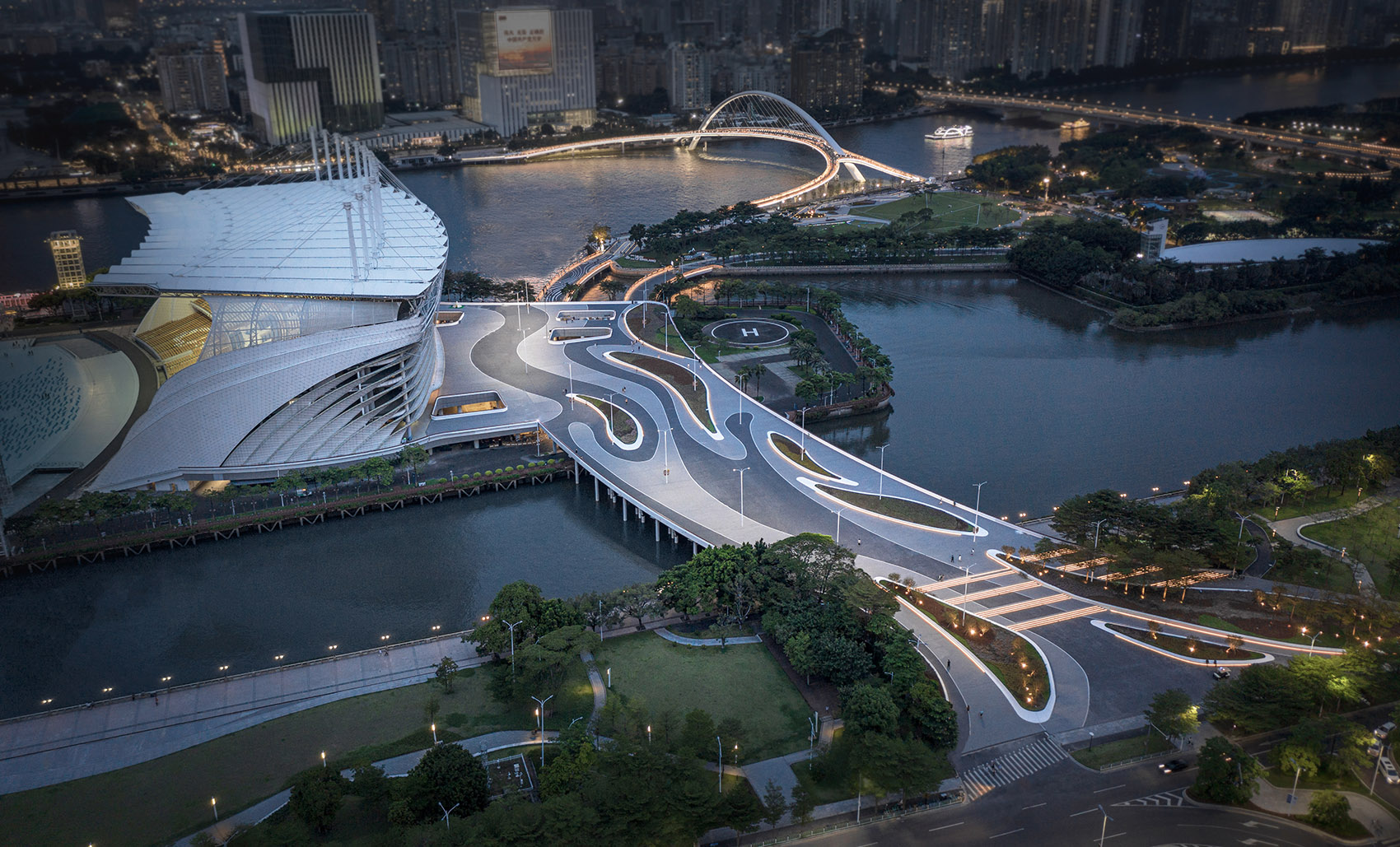
The renovation upgrade project of both banks of Guangzhou’s “new axis” is located on the northern section of that axis with a total area of 136,000 m² and connects the Zhujiang New Town CBD on the north with the South Square of the Canton Tower on the south via the Haixin Bridge as the river-crossing link. As a piece of this overall project, the Haixin Bridge North Bank Landscape Upgrade Project is located on the north side of the Pearl River, connecting Zhujiang New Town and Haixinsha Island through Bridge 3, and then connecting to Ersha Island Art Park through Bridge 5, and finally stretching to Haixin Bridge for a total project area of roughly 44,000 m². The north bank of the Haixin Bridge has been transformed into a brand-new landscape promenade after the upgrade, displaying a more glorious Guangzhou to the world.
▼项目改造前区位鸟瞰 A bird’s-eye view of the project area before the renovation upgrade ©华南理工大学建筑设计研究院有限公司
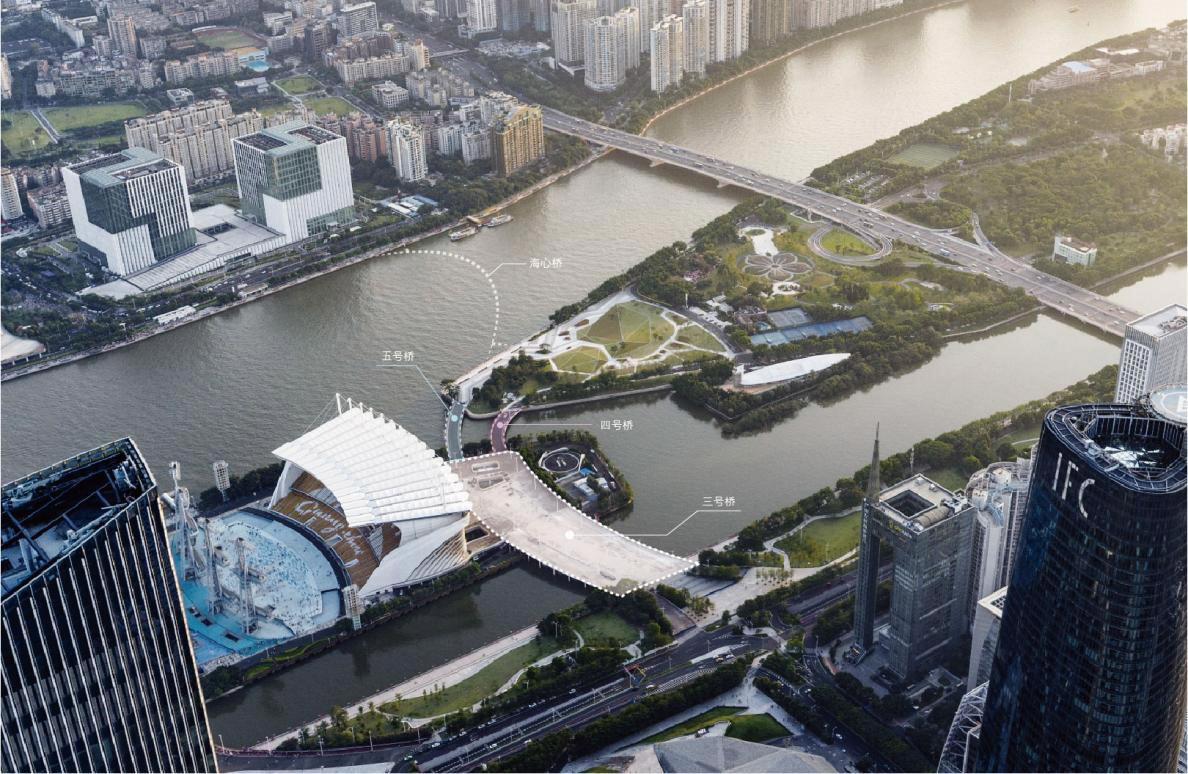
与海心桥相连后的景观长廊是连接广州新中轴的重要节点,沿途有广州大剧院、广东省博物馆等重要地标建筑,人流量极大,作为城市客厅的重要连接件,如何在营造观景平台、提升城市美感的同时,做到可及时疏散人流,这是一个挑战。
The landscape promenade connected to Haixin Bridge has become a vital node on the city’s new axis. There are several major landmarks along the way, such as the Guangzhou Opera House and Guangdong Museum, that generate heavy pedestrian flow as major attractions of the metropolis. How to continue improving these scenic sites and increasing their aesthetic appeal while at the same time being able to safely evacuate crowds in an orderly manner remains a challenge.
▼改造前的海心桥北岸区位分析 Site analysis before the renovation upgrade ©华南理工大学建筑设计研究院有限公司
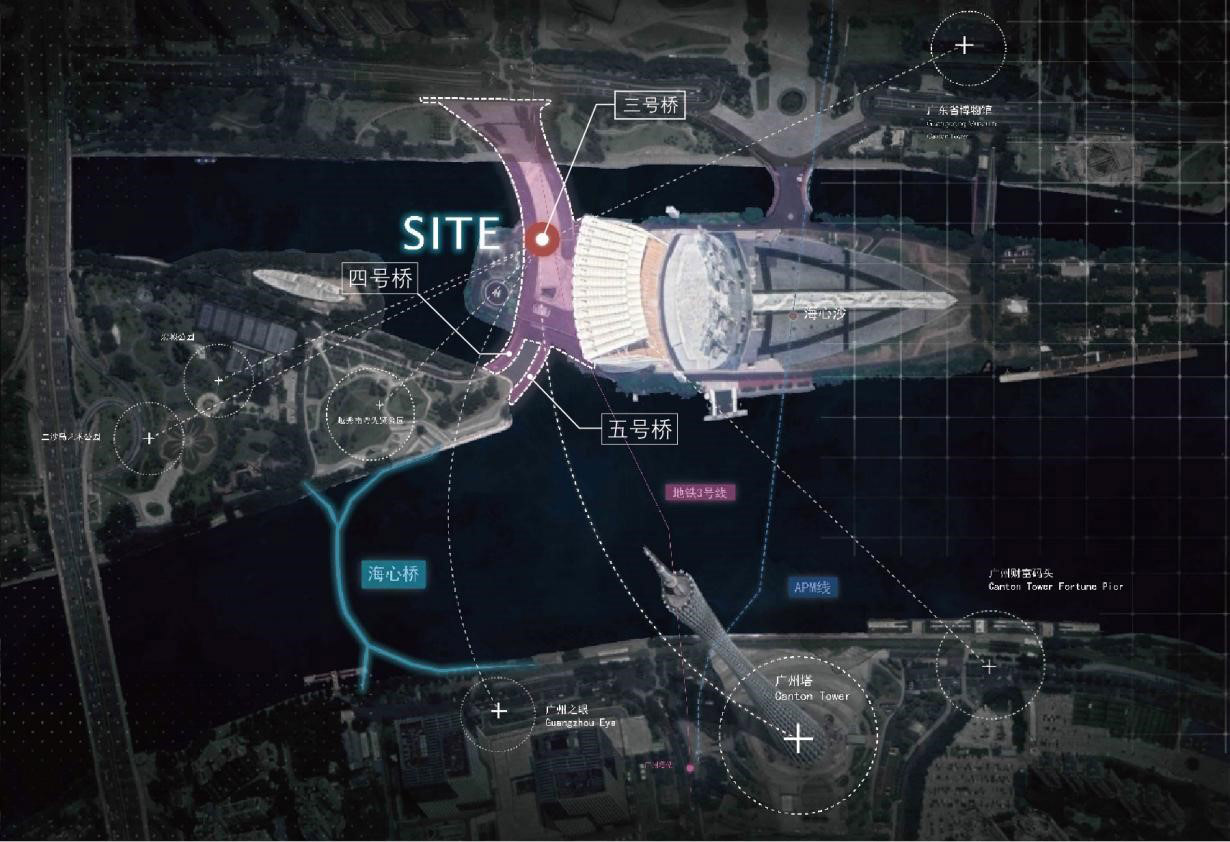
在改造之前,三号桥是为了亚运会场馆疏散人流而修建的一座人行桥,大面积的沥青桥面暴露在南国的烈日之下,行走其上燥热难耐。且通过一段压抑的疏散楼梯与四号桥和五号桥相连,平日并不开放。要让海心桥北岸这样的灰空间重新焕发生机,则亟需一次使用舒适度和景观观感的优化。
Prior to the renovation, Bridge 3 was a pedestrian bridge built for evacuating crowds from venues for the Guangzhou Asian Games. But the vast expanse of asphalt pavement in the scorching South China sun was too hot to walk on. The bridge was also connected to Bridges 4 and 5 through a flight of depressed evacuation stairs, which was not normally open. The north bank of the Haixin Bridge is well overdue for an upgrade to revitalize it into a comfortable and enjoyable place to spend time.
▼北岸改造前,动线不流畅,沥青桥面燥热难耐 The traffic flow was suboptimal and the asphalt pavement was too hot to walk on before the renovation upgrade ©华南理工大学建筑设计研究院有限公司

设计团队决定采用链接+疏散+观景的方案策略,把三号桥及五号桥进行联通,优化动线,用塑造景观桥的方式,与海心桥相连通将南北融为一体,成为互联互通的慢行通道,将珠江沿线核心景观一览无余。并借此实现人车分流,有效地将游客安全、有序地引导。
改造具体手法: 1. 用流线的铺装与绿化延续花桥形态,打造连续一体的景观 2. 利用空间的收放关系以及景观铺装暗示,引导疏通桥头人流 3. 景观花池增加休憩功能,与慢行通路结合形成聚集观景场所
Our design team adopted the strategy of “Connection + Evacuation + View”, that is, linking up Bridge 3 with Bridge 5 to optimize traffic flow, and then connecting to Haixin Bridge through a landscape bridge, linking up the north and south banks to create a landscape promenade. This interconnected, non-motorized passage contributes to an uninterrupted view of major sites along the Pearl River. It also allows pedestrians and vehicles to remain separated, and tourists can be guided in a safe and orderly manner.
Renovation methods: 1. Employ contour pattern walkways and landscaping to maintain the “flower bridge” look for a consistent and continuous landscape. 2. Maintain free traffic flow by guiding the crowds using spatial techniques and landscape pavement to guide the flow of people at the bridge entrance. 3. The landscape flower beds, together with non-motorized pathways, function as rest areas while doubling up as a scenic spot.
▼改造设计手法表现 Graphic rendering of the renovation upgrade design ©华南理工大学建筑设计研究院有限公司
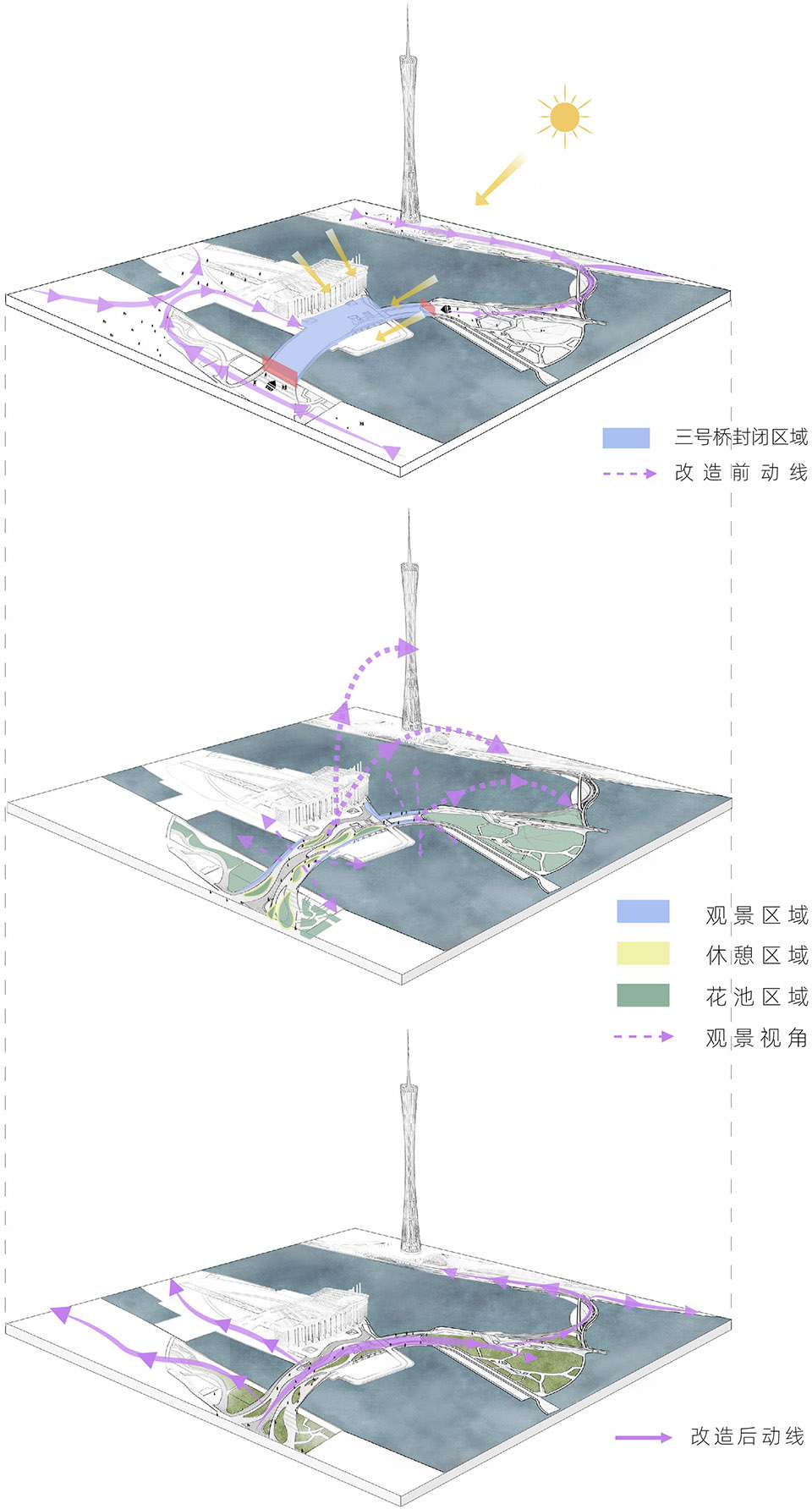
从区位链接来说,改造区域作为广州塔周边景观改造项目的组成部分,南衔海心沙,北接珠江岸,将花城广场、海心沙亚运公园和二沙岛艺术公园连缀起来,在繁华的都市中心铺就一条步行可达的休闲景观带。从城市作用来说,它串联沿线重要景点、设施,编织形成了活力效应互相叠加的滨水热点网络。作为城市客厅的连接件,按城市道路等级和具体节点人流情况,考虑了密集人员疏散的要求,这便是对于疏散通道的另一种诠释。
As a major part of the landscape around the Canton Tower, the renovation area will connect the Haixinsha bank in the south with the Pearl River bank in the north, and will link together Huacheng Square, Haixinsha Asian Games Park, and Ersha Island Art Park, paving the way for a leisurely pedestrian scenic zone right in the city center. In terms of the functionality provided to the city, it connects major scenic spots and infrastructure along the way, weaving them into a waterfront hotspot. As a connector of the city’s major attractions, the levels of urban roads, the traffic flow of specific points, and crowd evacuation requirements are all considered, reflecting the next level of evacuation passageway design.
▼北岸景观长廊与两岸链接流线示意 Schematic diagram of the landscape promenade on the north bank and the traffic flow linking both banks ©华南理工大学建筑设计研究院有限公司
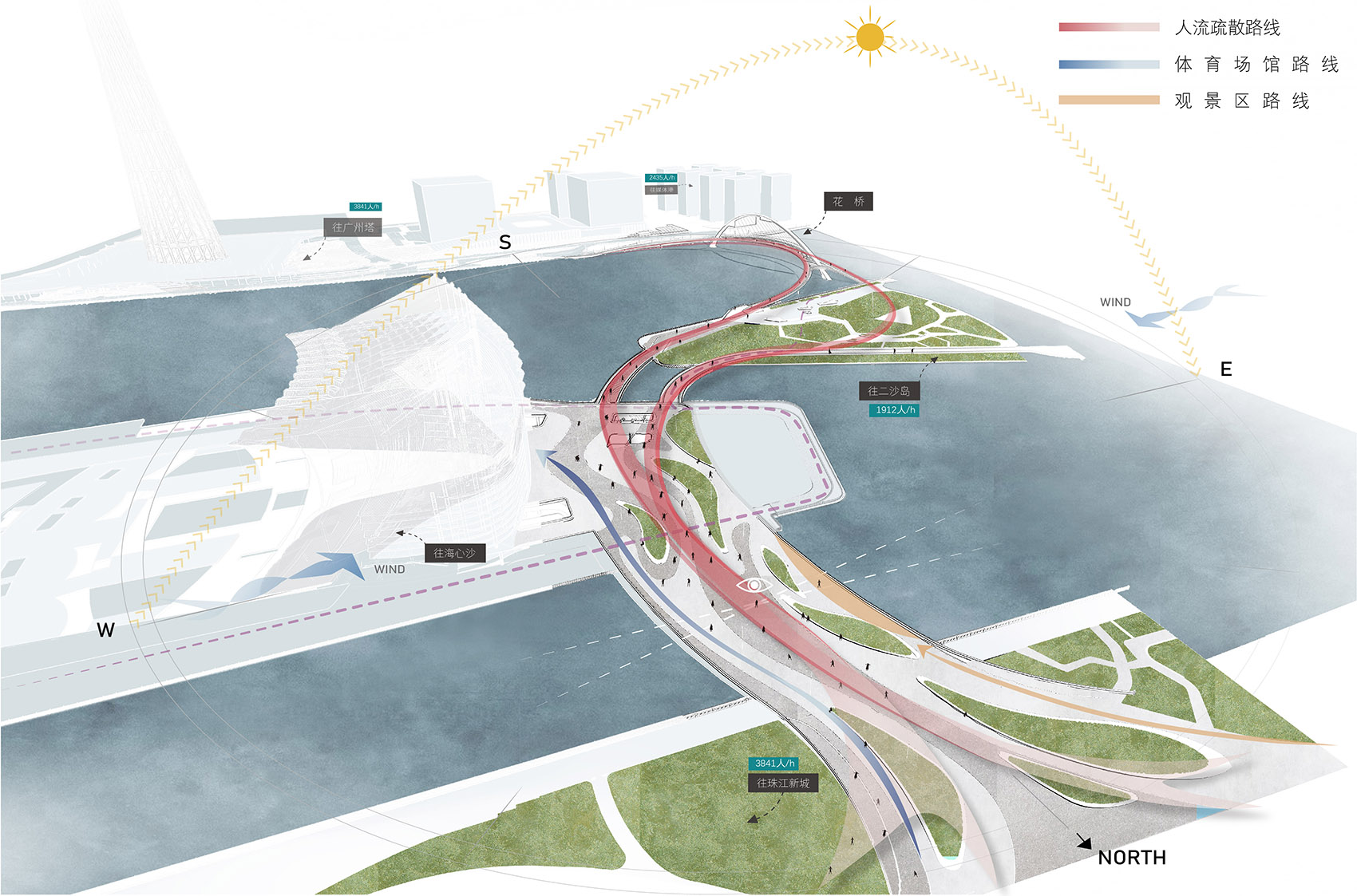
由于结构荷载的限制,三号桥无法承担起过重的大型景观装置与高大的园林植物,于是设计团队选择将景观改造的重点放在了铺装和轻型花池上。
Due to structural load restrictions, Bridge 3 could not support large or heavy landscape installations or tall garden plants, so our design team shifted the renovation focus to pavements and lightweight flower beds instead.
▼三、四、五号桥,在珠江新城、海心沙与二沙岛艺术公园打通步行流线 Bridges 3, 4, and 5 connect the pedestrian traffic flow between Zhujiang New Town, Haixinsha, and Ersha Island Art Park ©超越视觉
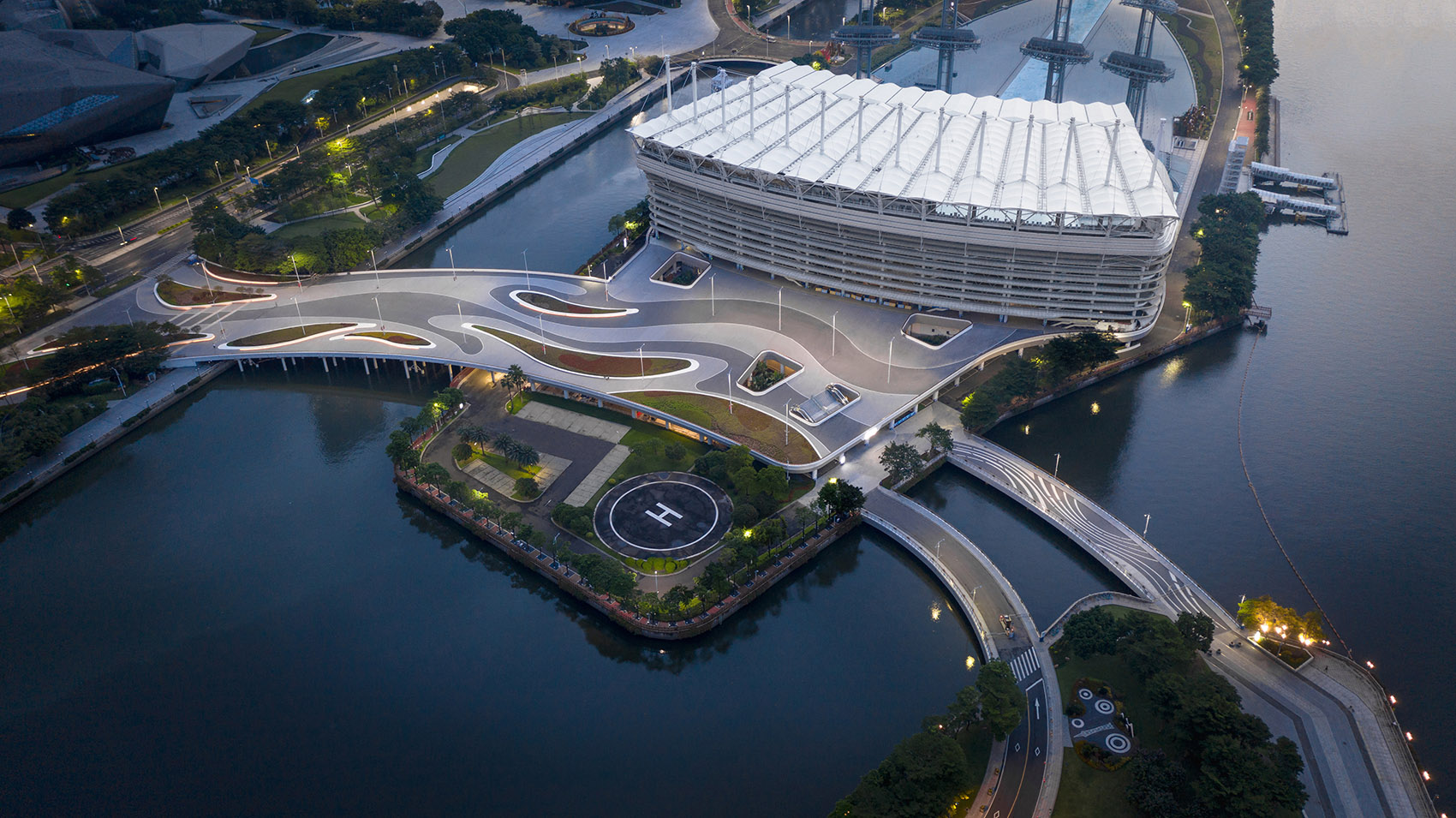
▼从临江大道俯瞰三号桥 Overlooking Bridge 3 from Linjiang Avenue ©超越视觉
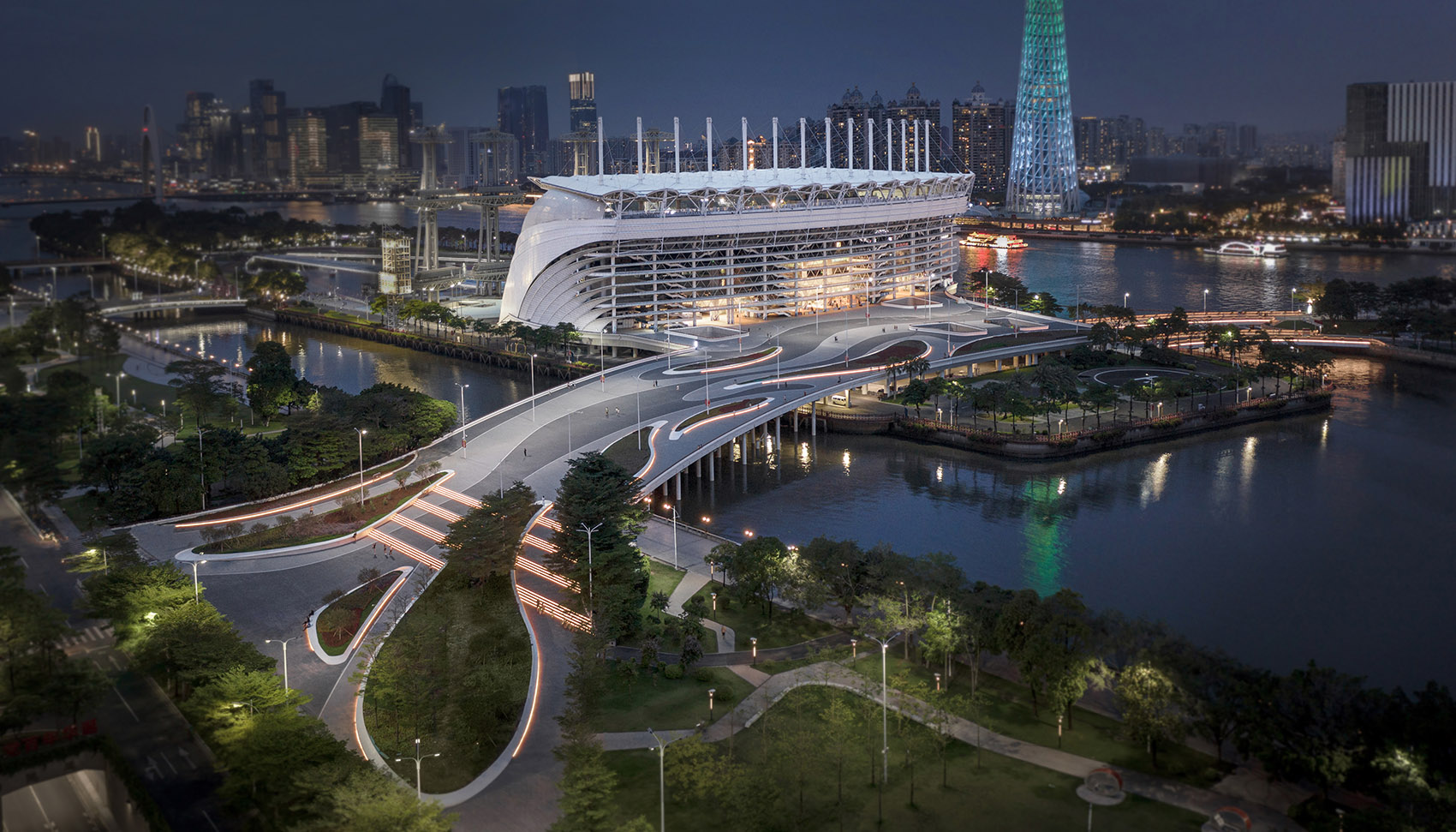
该项目取用粤剧水袖、岭南花舟等岭南传统意向,结合现代的表达手法进行设计,既传达了千年府城的传统风韵,又呼应了国际都市的时代节拍。
The project’s design integrates traditional Lingnan images, such as long flowing sleeves from Cantonese opera and Lingnan flower boats, with modern expression techniques. It not only represents the traditional charm of an ancient city with a history of several thousand years, but also resonates with the modern rhythm of this international metropolis.
▼具有在地性的文化元素与铺装推敲 Regional cultural elements and meticulous attention to the pavement design ©超越视觉

以水袖一般的流线作为基本的构图元素,花池和铺地结合,勾勒出流畅的肌理。其中灰白铺装水纹波转,白色的舟状花池卧于桥面,盛着四季各异的亮丽花卉,仿若花舟置于流水之上,充满岭南的浪漫风情。
Using lines inspired by long sleeves as the basic graphic element, the combination of flower beds and walkways creates a feeling of smoothness. The gray and white walkways form concentric ripples, and white boat-shaped flower beds with beautiful flowers varying by the season are placed on the bridges like a flower boat floating on the river, giving an air of authentic Lingnan-style romance.
▼抽象后的水袖造型排列带给桥面丰富动态的观感体验 The layout of abstract long-sleeve lines offers a rich and dynamic viewing experience ©超越视觉
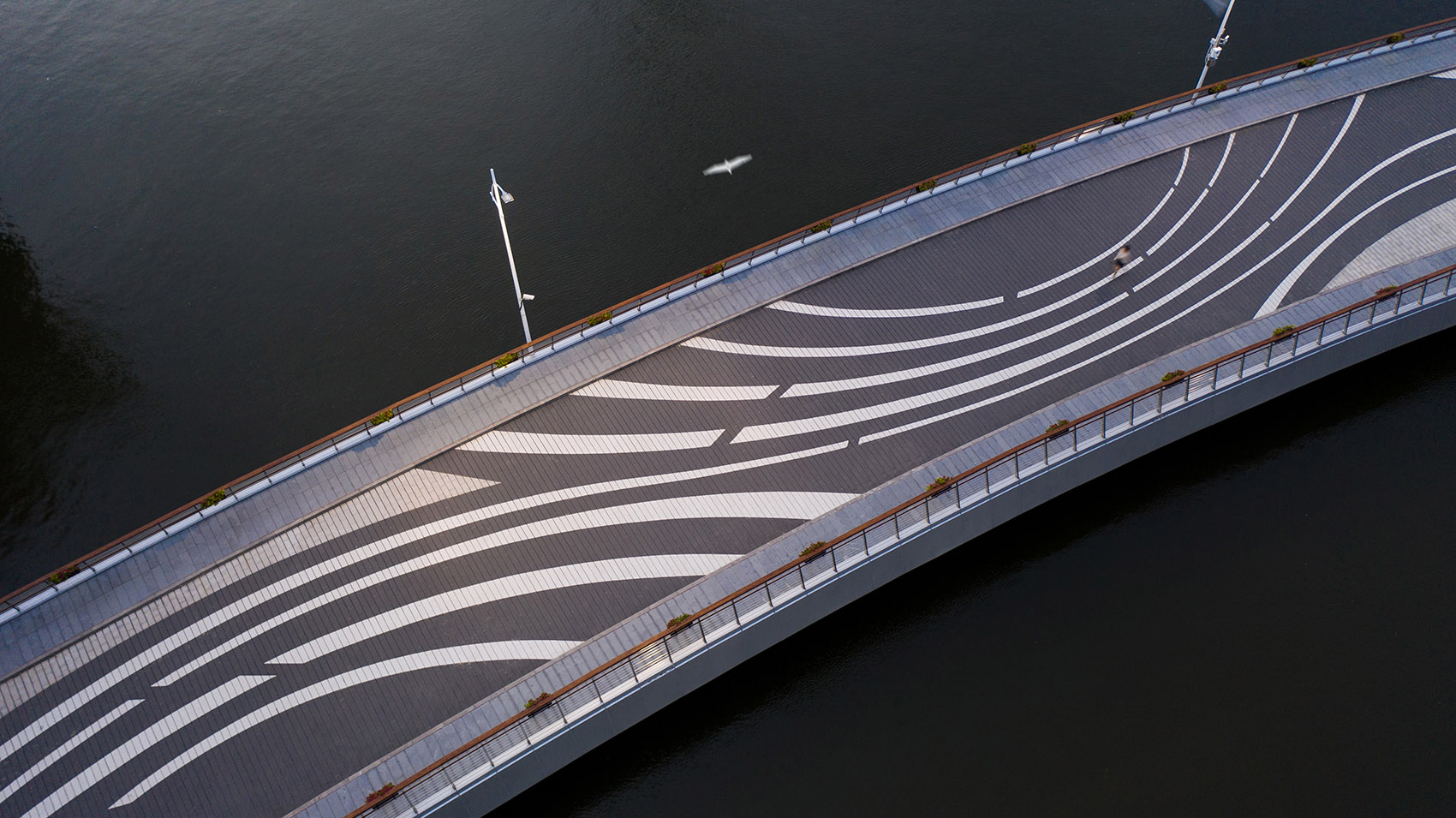
四号、五号桥的铺装同样进行了设计,其中五号桥从海心沙亚运场馆中提取了流线形式,绘制在桥面上;四号桥则相对素净,形成对比,整个项目和谐统一。
Bridges 4 and 5 were re-paved as well. Bridge 5 adopts the streamline form of Haixinsha Asian Games Stadium while Bridge 4 remains relatively neutral, forming a contrast and providing a nice complement to Bridge 5.
▼抽象后的水袖造型排列带给桥面丰富动态的观感体验 The layout of abstract long-sleeve lines brings a rich and dynamic viewing experience ©超越视觉

▼五号桥上,市民进行跑步锻炼 A resident jogging on Bridge 5 ©超越视觉
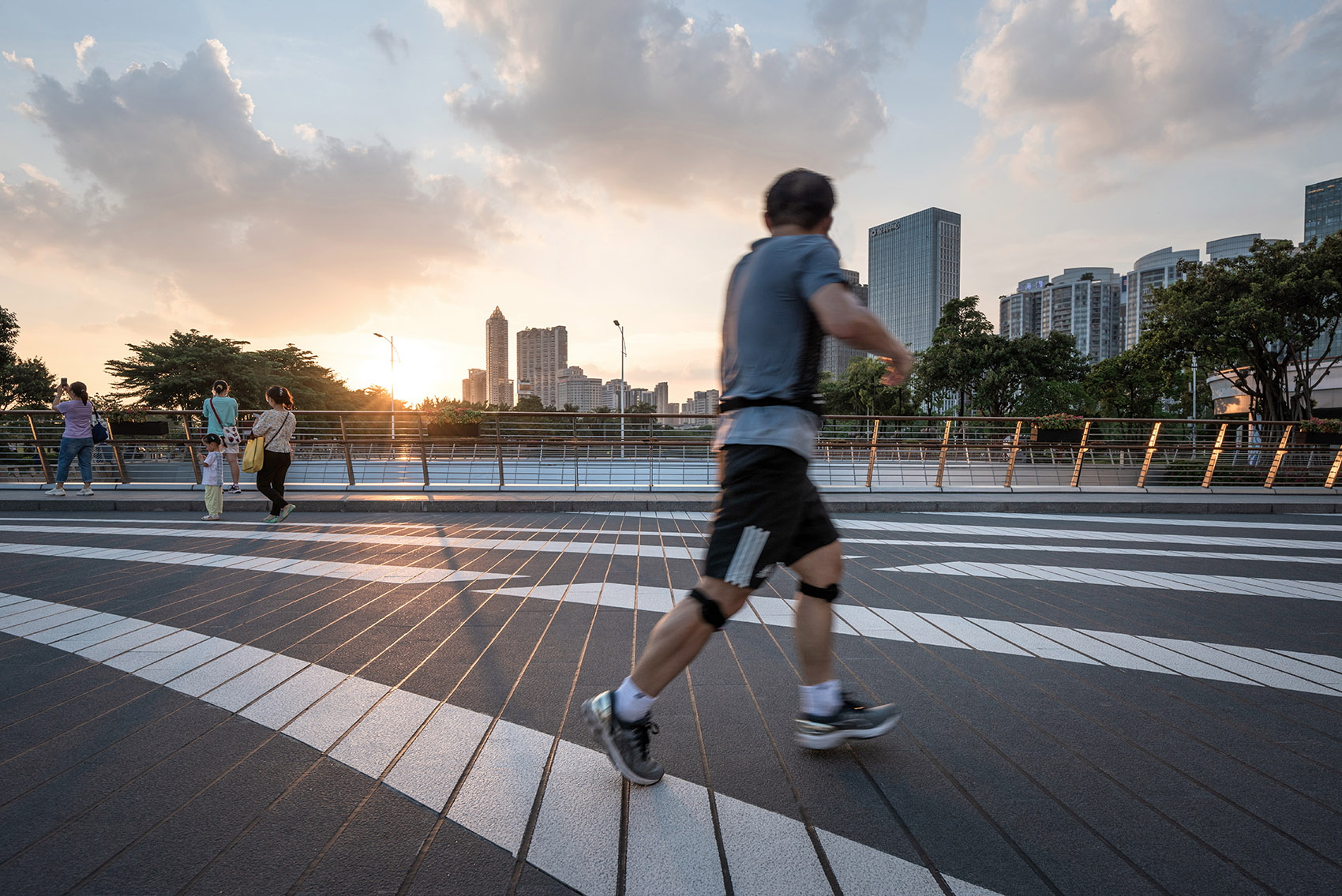
为了应对三号桥原设计承重有限的情况,团队设计了空心的流线花池,花池尽端伏低,过渡到地面,有效地减轻了整个桥面设施的重量。
To cope with the limited load-bearing capacity of Bridge 3, our team employed a design of hollow, contour shaped flower beds with their ends sloping toward ground level, largely reducing the weight load on the bridge.
▼处于广州时代感最为强烈的地区,三号桥的整体表达选择了现代简约的风格,以流线元素贯穿整个设计 Located in the heart of downtown Guangzhou, Bridge 3 on the whole is modern and simple, with contoured elements throughout the design ©超越视觉

▼与铺装同节奏的流线型花池 Contour shaped flower beds in sync with the walkways ©超越视觉
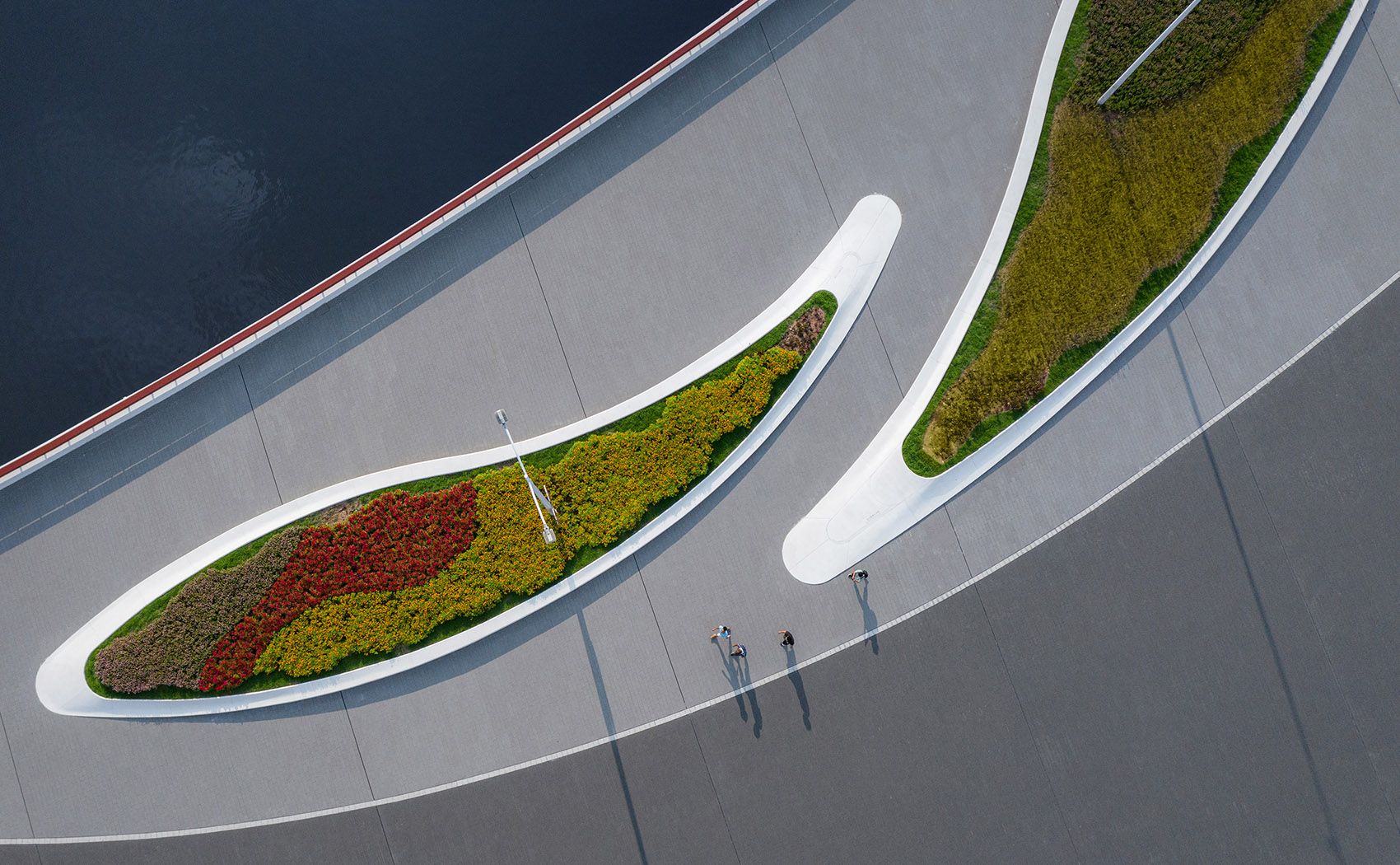
充满形式感的桥面搭配满目葱郁的植物景观,改变了原来的阴沉压抑。加装的灯光以地灯的形式出现在花池底部,减少负荷的同时也营造了温馨的城市氛围。地面铺装和花池以黑白灰为主色调,白色花池,内部空心,尽端伏低贴近地面,减少桥的负重,花池中植物多为鲜艳品种。
The previous gloominess and depression were replaced by the beautifully shaped walkways and lush and vigorous vegetative landscape. In addition, floor lights were installed on the bottoms of flower beds, further lessening the weight load while also creating a warm city feeling. Black, white, and gray are the primary colors of the walkways and flower bed structure. White hollow flower beds slowly descend to ground level and reduce the weight load on the bridge. The plants in the flower beds are typically bright-colored flowers.
▼贴近地面的花池 Flower beds slowly descend to ground level ©超越视觉
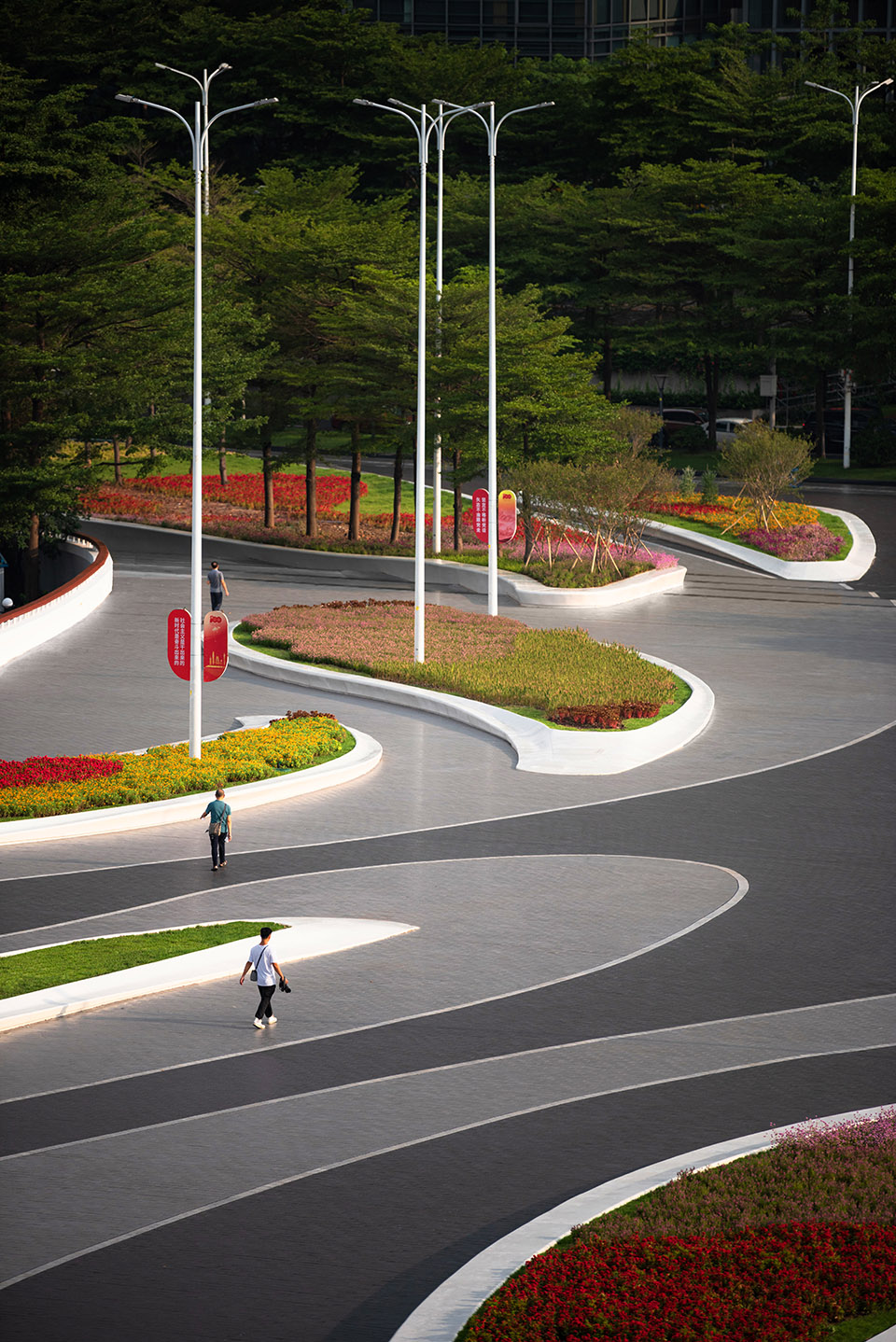
▼保留原有高大乔木以及高杆灯 Existing trees and high-mast lighting are preserved ©超越视觉
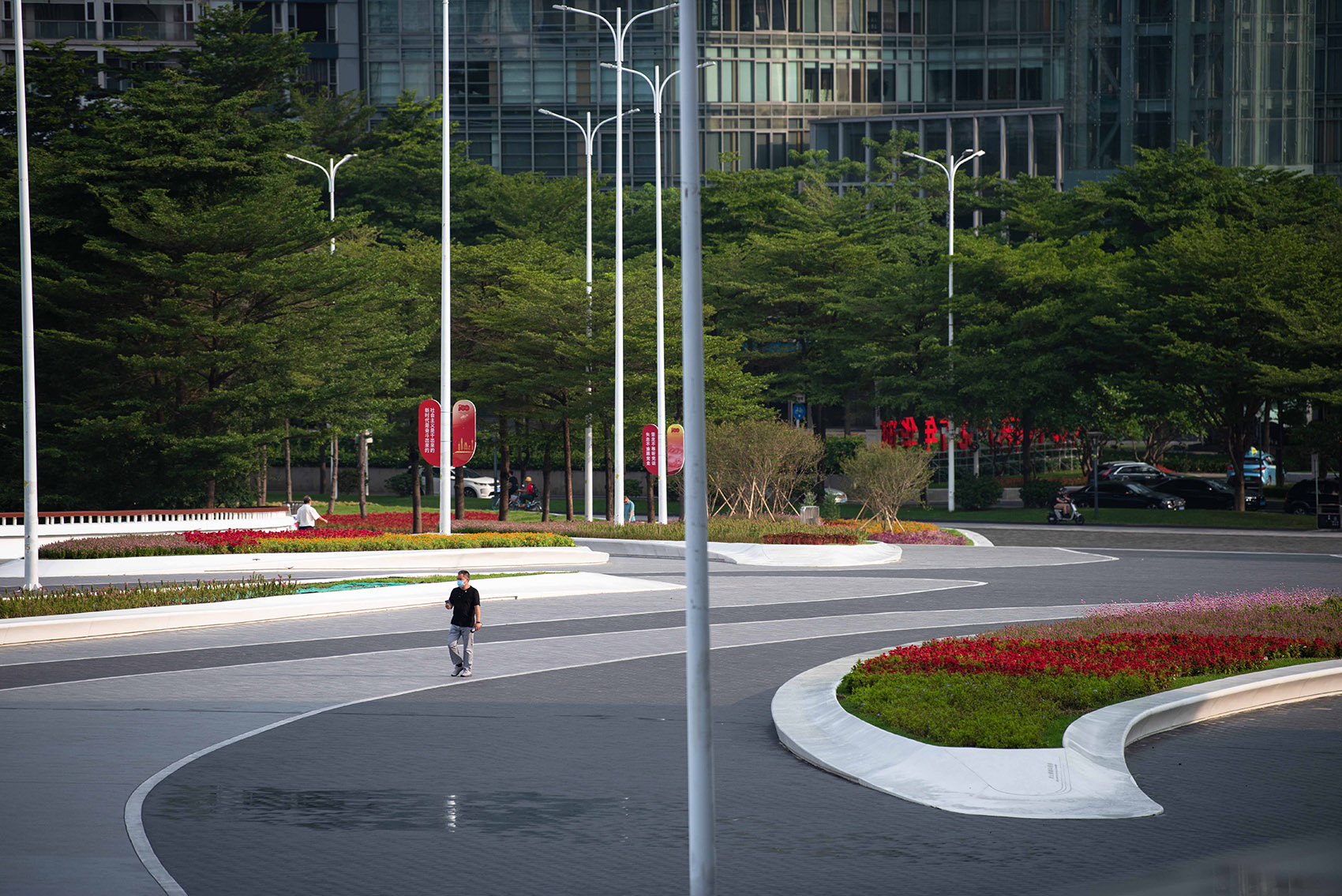
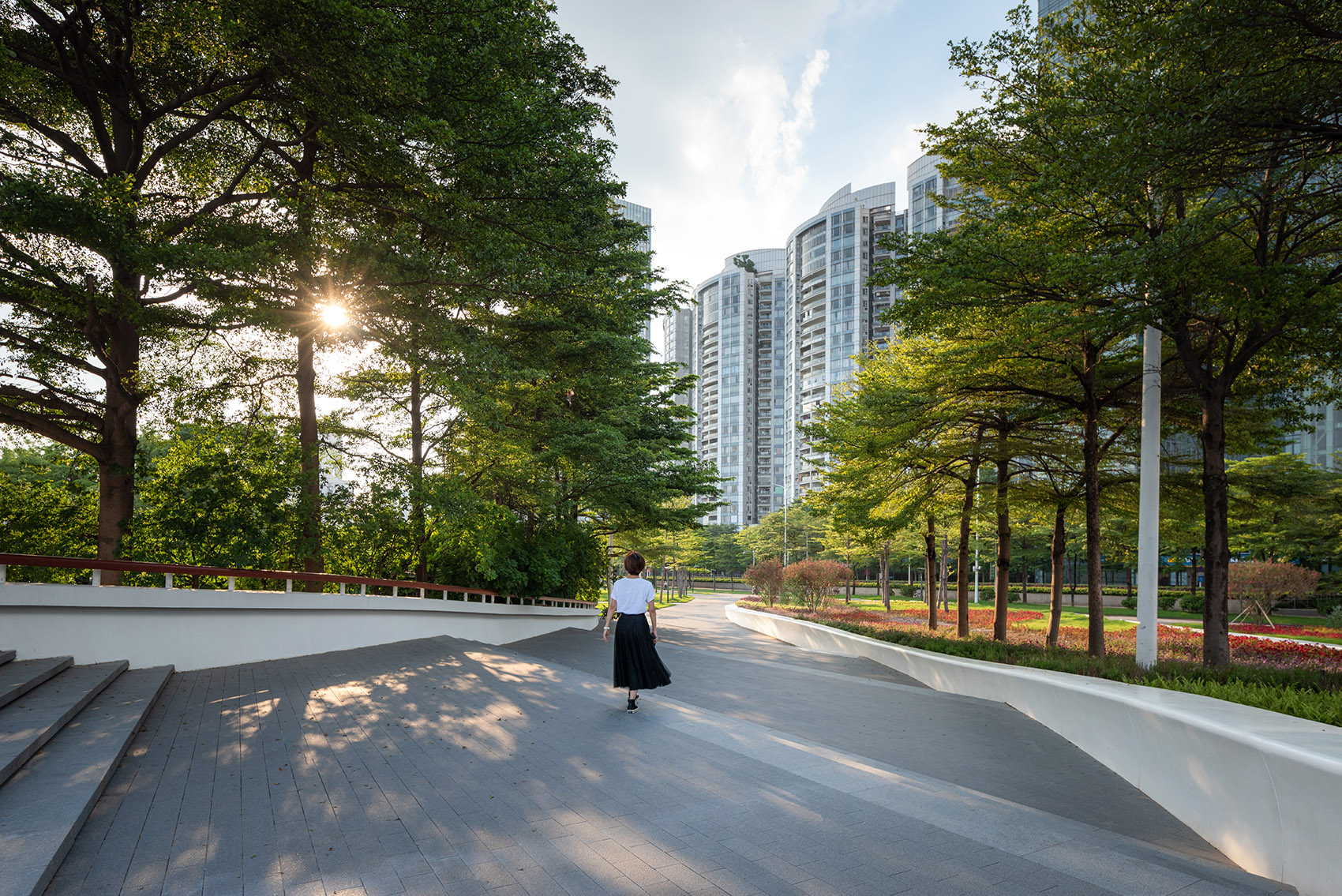
改造后的北岸为广州市民的休闲提供了去处。每至夜晚,珠江两岸华灯初上,三号桥就聚集起大量散步活动的市民,为城市的CBD带来市井般的热闹。
The upgraded north bank provides a recreational space for local citizens. When the sun sets and both sides of the Pearl River illuminate, many residents come to take a stroll on Bridge 3, bringing energy and life to the CBD.
▼傍晚,在附近结束了一天的劳碌的市民来到三号桥散步 People take a stroll on Bridge 3 in the evening after a day’s work ©超越视觉
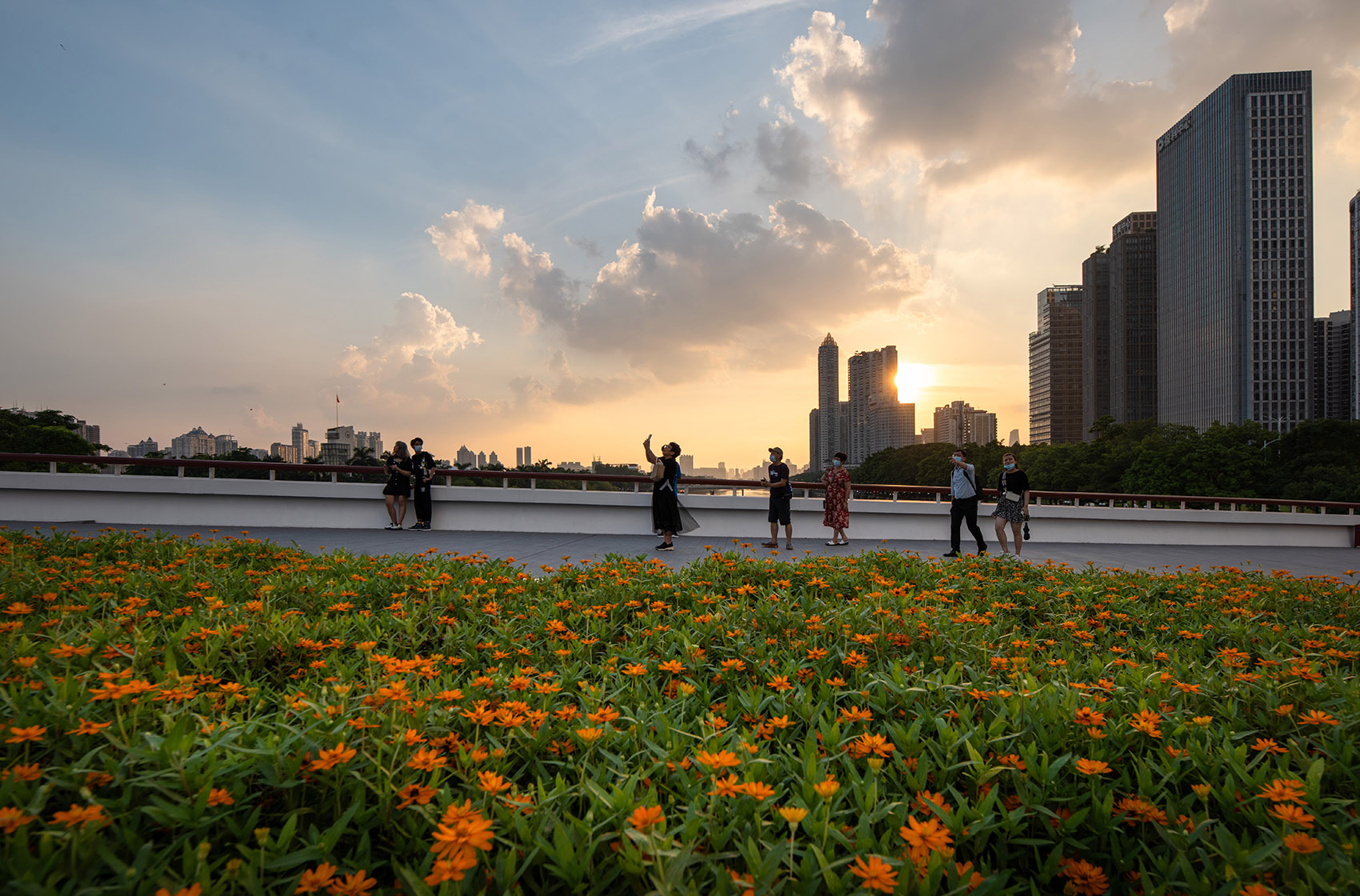
▼入夜时分,花池下的地灯亮起,融入珠江景观带的灿灿霓虹之中 The ground lights shine in the night, blending into a cluster of brilliant neon lights along the Pearl River ©超越视觉
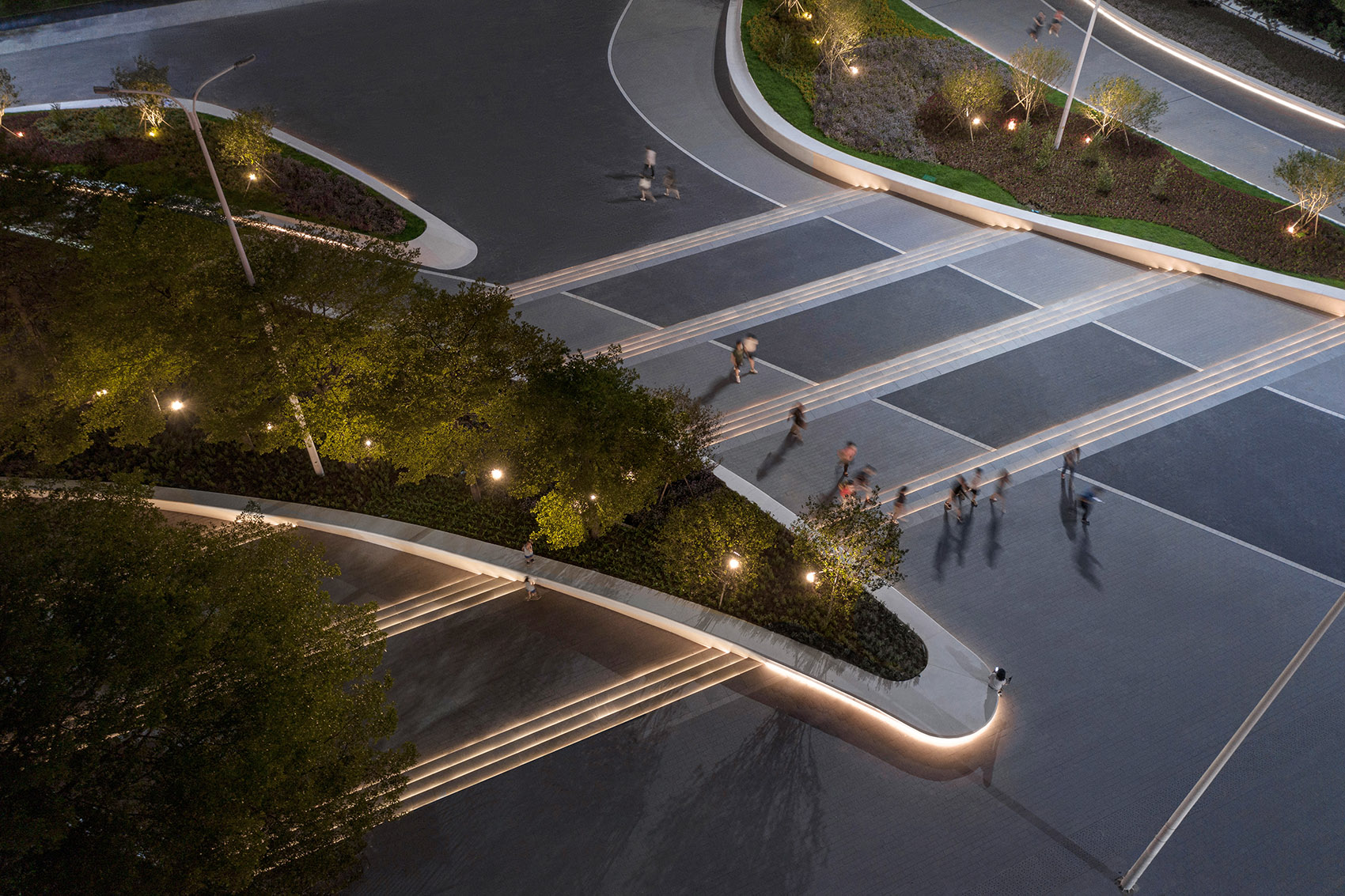
北岸步行桥的改造与重新开放鼓励了二沙岛和珠江新城之间的步行通行,在过度发展的机动车交通网络里开辟了一条有机出行的通道。在这条步行专属的道路上,市民能够安心地享受珠江的风景,不受CBD里车水马龙的干扰。
The upgrading and reopening of the pedestrian bridge on the north bank encourages people to walk between Ersha Island and Zhujiang New Town, and opens up a green walkway in the midst of the over-developed motor vehicle traffic grid. On this vehicle-free promenade, people can enjoy the Pearl River scenery at ease, free from the hustle-and-bustle of the CBD.
▼漫步于景观桥上的人群 People strolling on the bridge ©超越视觉
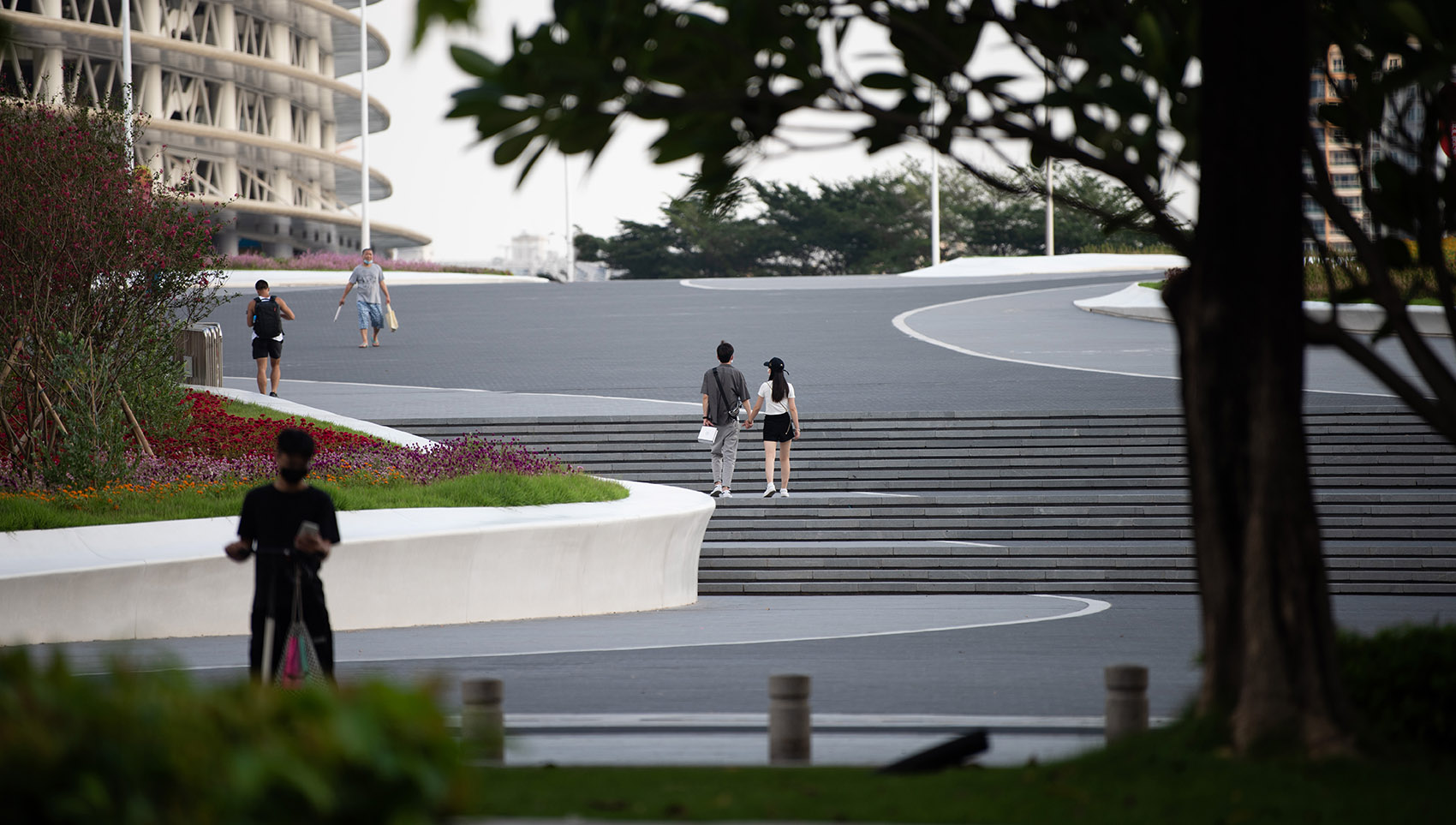
作为城市公共空间,海心桥北岸表现出极强的市民亲和力。夜晚的桥面上,色调温暖的灯光亮起,为人群的活动营造柔和的氛围。在流线型花坛的使用方式上,花池边沿高度适合的部分大多为休憩的市民所占据,在花丛边吹着江风,看一江两岸灯火霓虹,而与地面衔接温和缓坡为儿童的游戏提供了免费的场地。
As a public area of the city, the north bank of Haixin Bridge has a strong affinity with residents. The flickering warm-toned lights on the bridge create a soft atmosphere for people at night. Another function of the contour shaped flower beds is making certain sections at a height that offers a resting spot for passing people. With the gentle river breeze and surrounded by a floral fragrance, they admire the river scenery and the liveliness nearby. The gentle slopes near the ground, on the other hand, have become a free playground for children.
▼在景观桥上肆意奔跑的孩子 Children running around on the bridge ©超越视觉
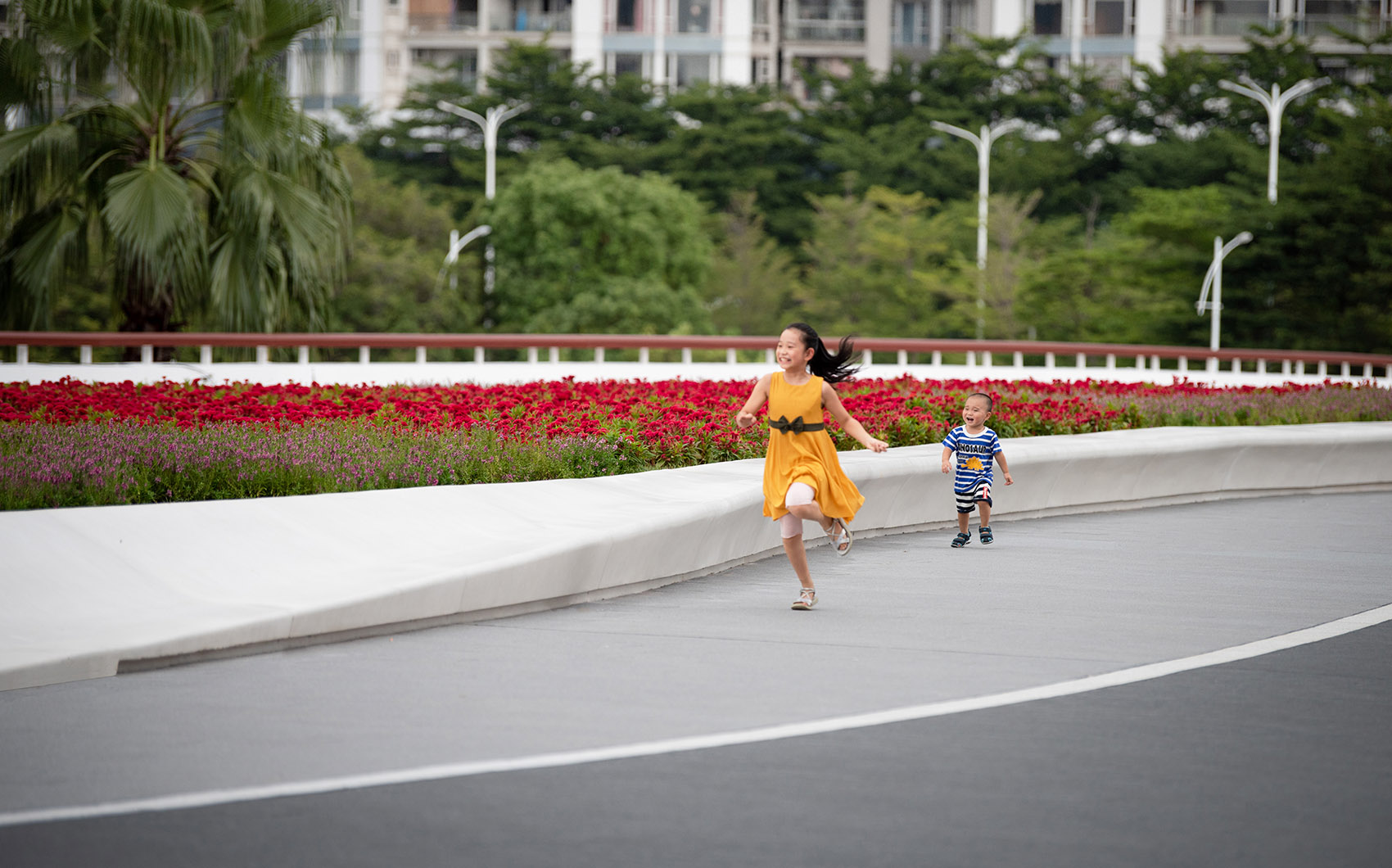
▼孩子趴在栏杆边欣赏江景 Children lean on the railing, admiring the river view ©超越视觉
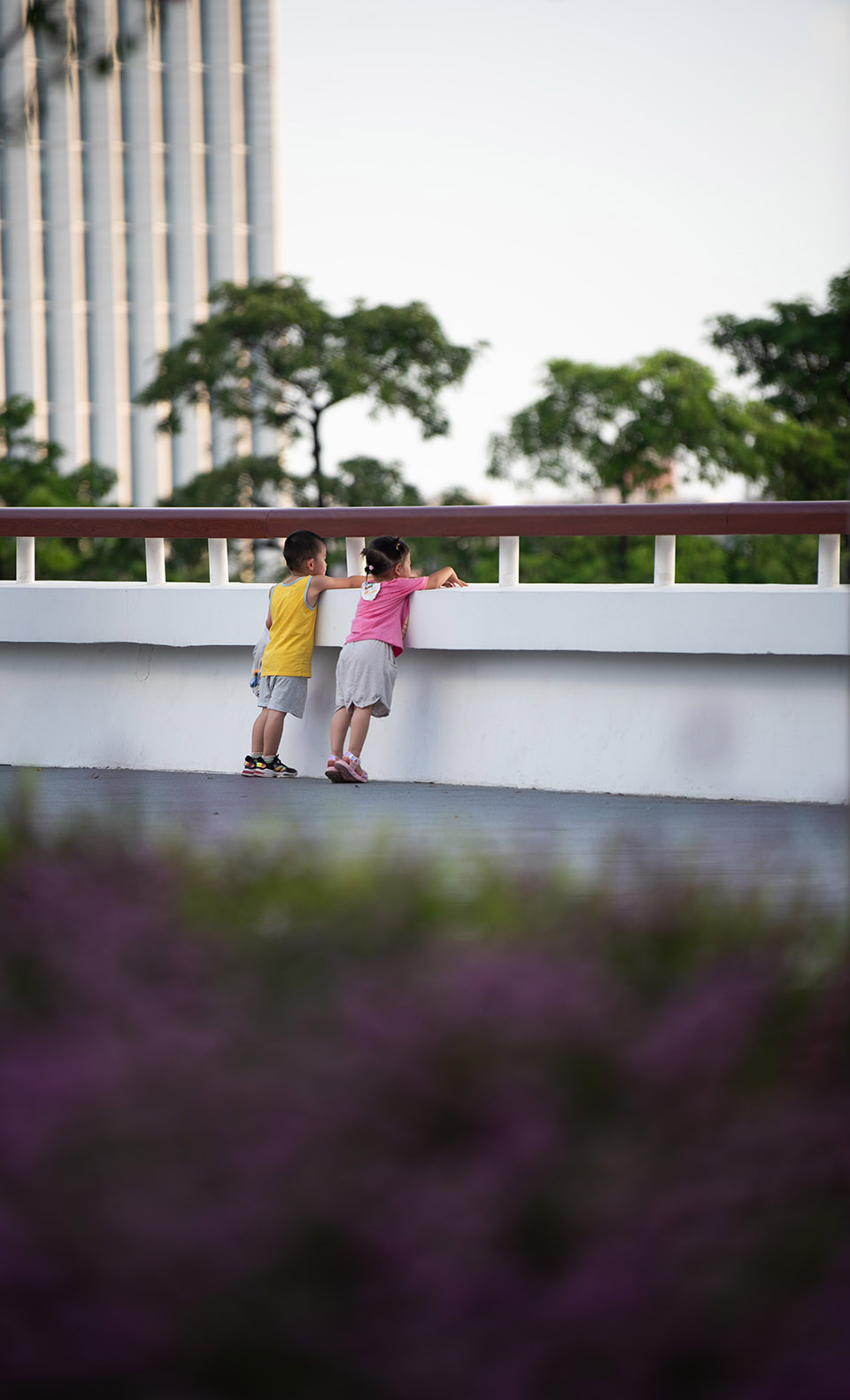
北岸景观提升项目的导视系统自北向南贯穿中轴步行动线。 导视系统的外观造型与其周边建筑和谐统一。体现了广州这座城市的简约性,多元性和国际化的审美。
The way-finding system of this project runs through the “new axis” walking line from north bank to south. The appearance of the way-finding system is in harmony with Zhujiang New Town CBD skyline architects. The design of this wayfinding system embodies the simplicity, diversity, and contemporary aesthetics of the city of Guangzhou.
▼导视系统中的每一个牌子设置有对应编号,以便行人快速在总览地图上对应灯杆编号,识别自己的定位 Each sign in the guidance system is set with a corresponding number, pedestrians can quickly identify their positioning by corresponding to the light pole number on the overview map ©超越视觉
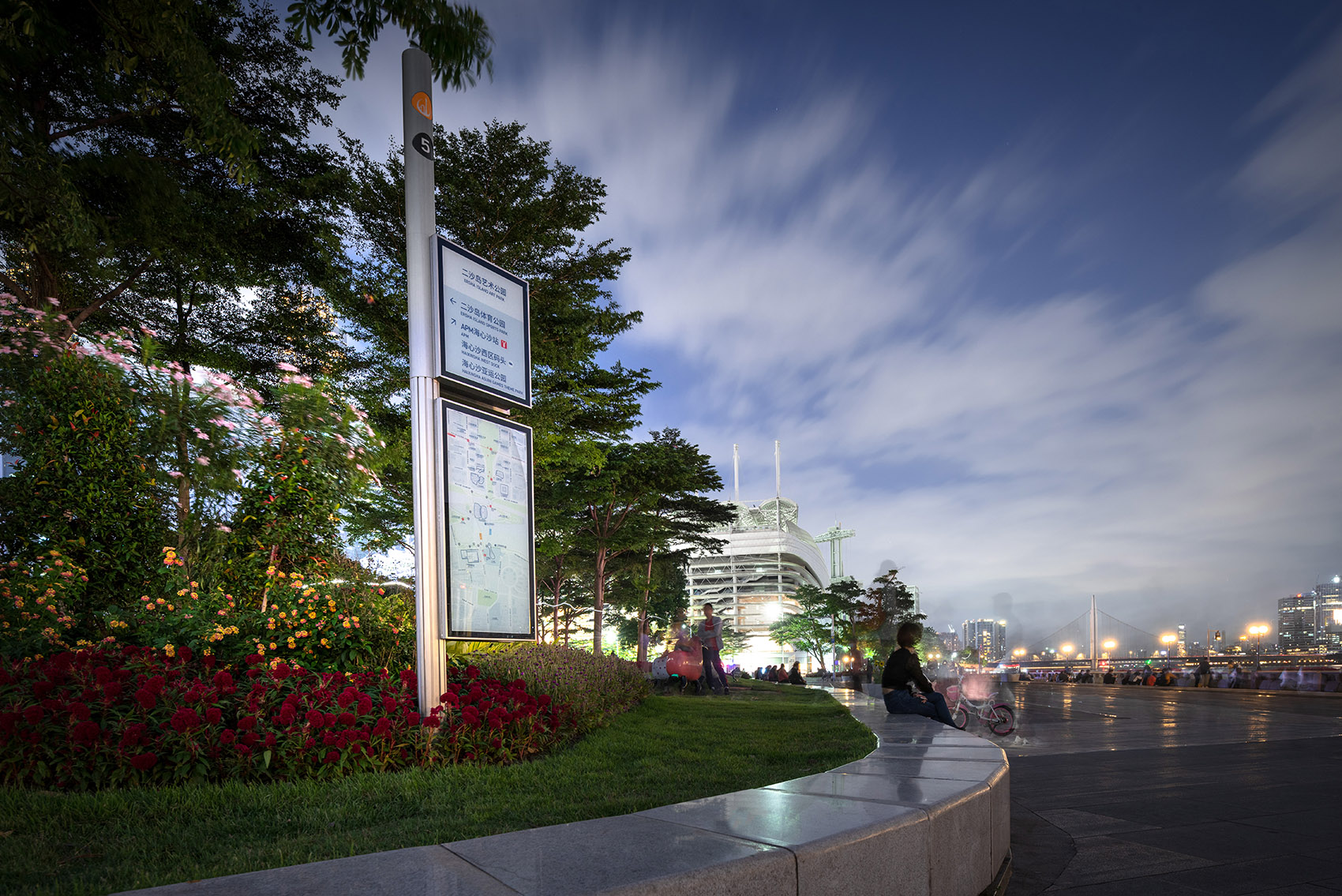
根据北岸景观提升项目中不同的景观场域需求,导视系统作为一种结合环境与人之间关系的信息传达体系,在其保持外观造型的统一和信息传达的便利前提下,衍生出了不同尺寸和规模的导视类城市家具。
According to the different landscape field requirements in the Haixin Bridge North Bank Landscape Upgrade Project, the way-finding system, as an information transmission system that combines the relationship between the environment and users, has derived different forms under the premise of maintaining the unity of appearance and the convenience of information transmission. Guiding city furniture of multi-size and scale.
▼北岸景观区域内的两种不同的导视款式 Two different types of kiosks located within this project area ©超越视觉
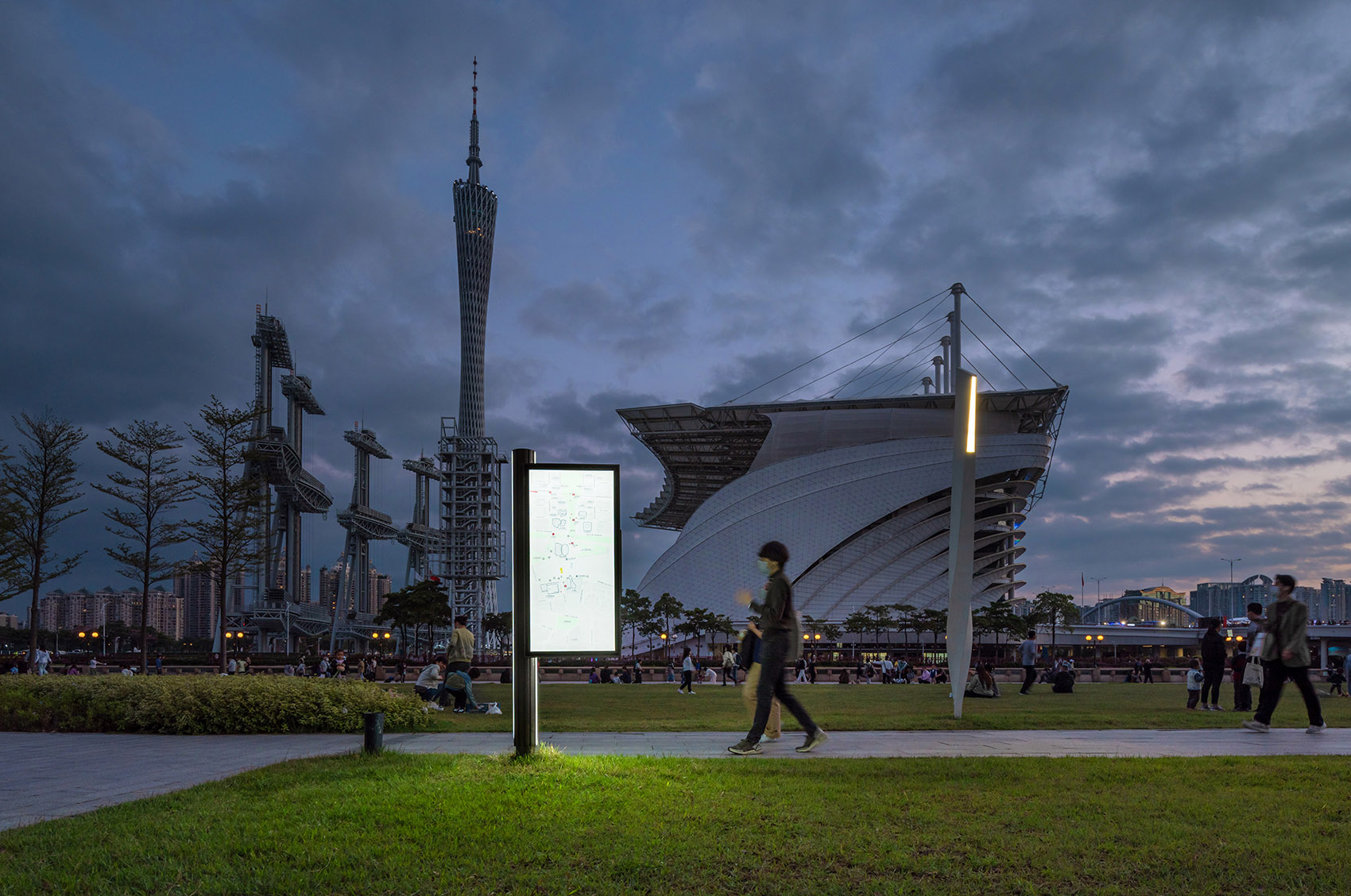
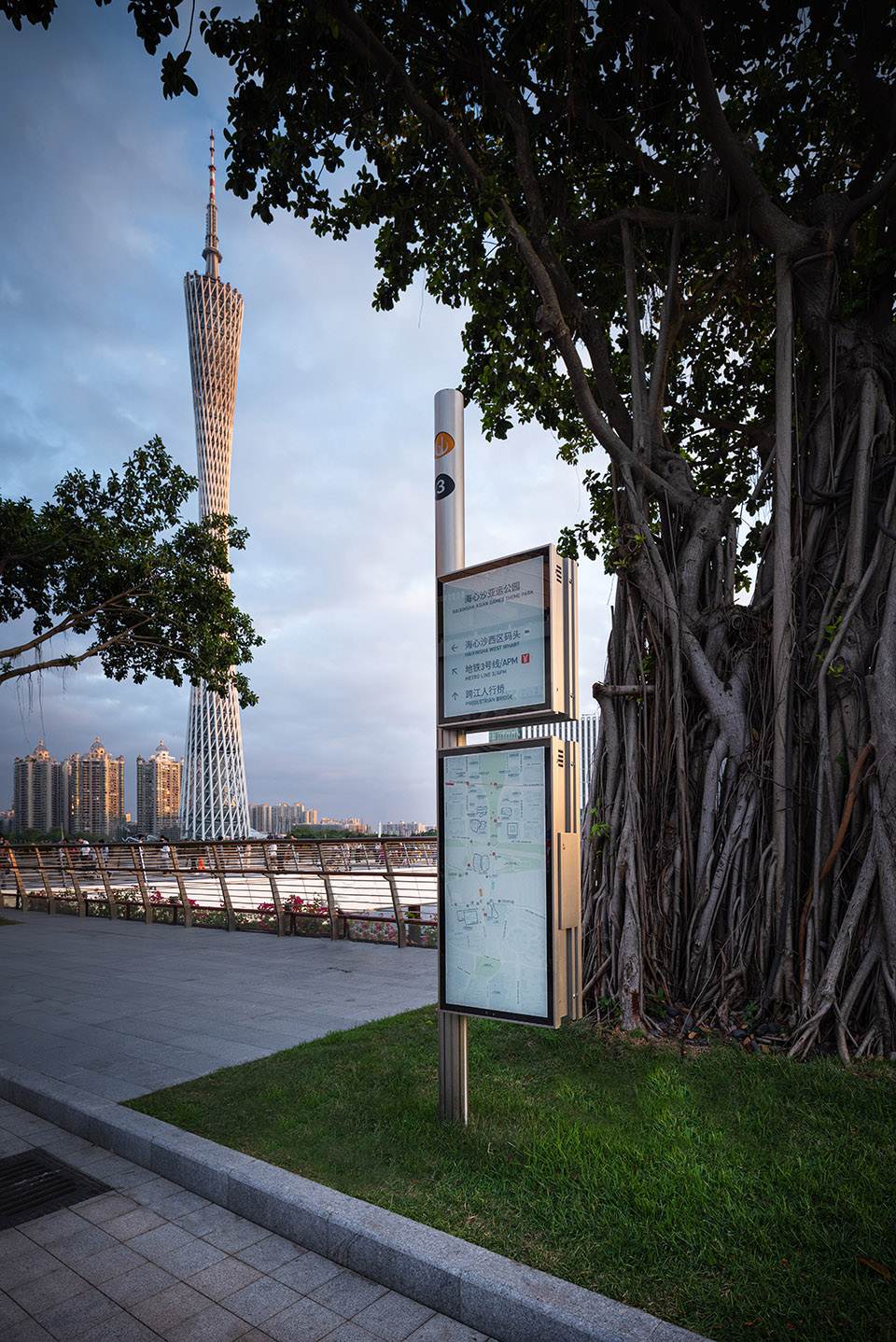
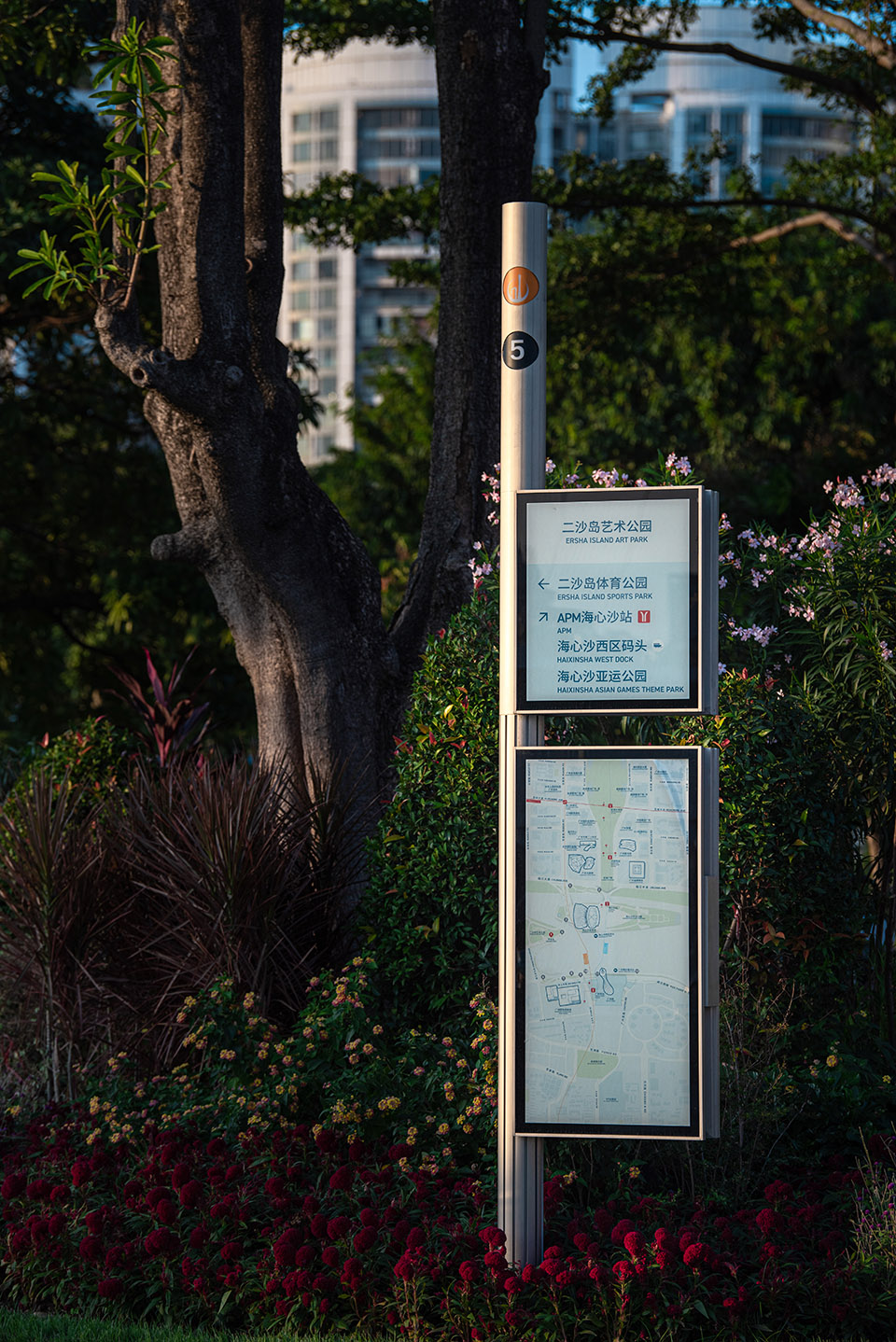
▼海心沙3号桥南端发光LOGO字体 Haixinsha luminated letter signage and the south end of Bridge, which can be seen from south bank ©超越视觉
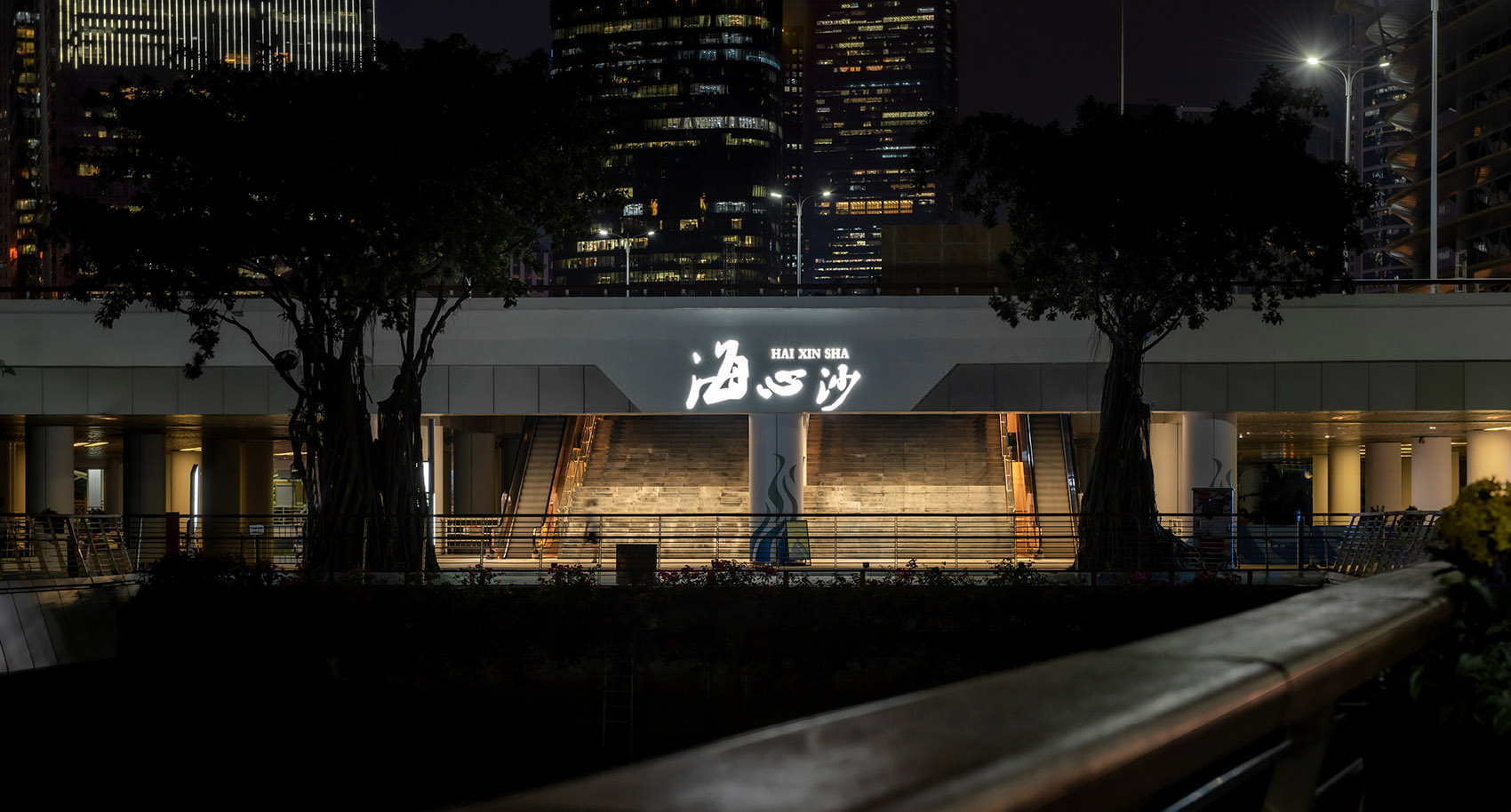
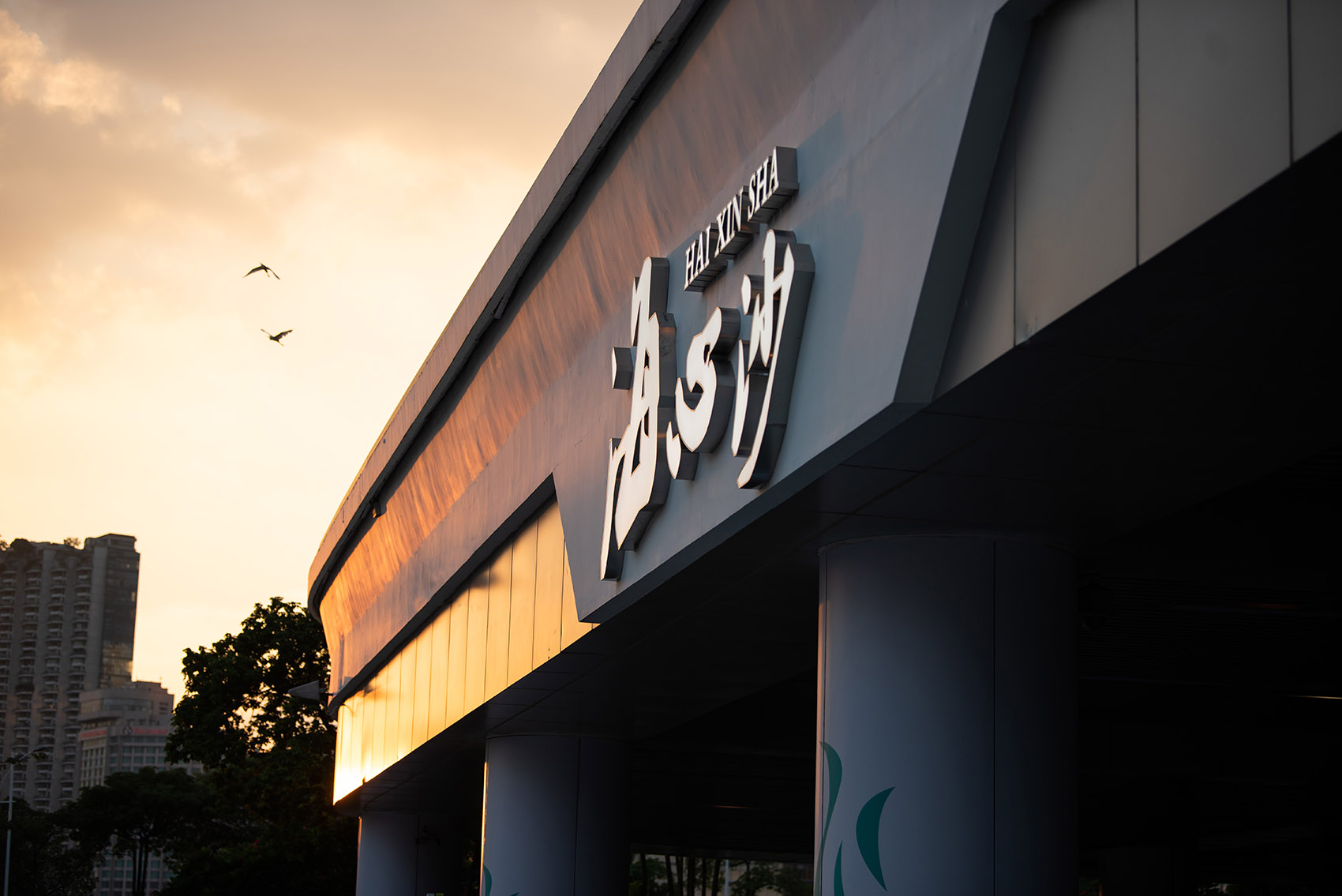
桥是一种纽带。而海心桥北岸的步行桥系统与珠江、广州塔和海心沙花桥一起,组成一片富有广州特色的旖丽风景。同时打造了新的城市文化与城市认同,形成市民的共同记忆。来自五湖四海的人们共同享有海心的花和珠江的风,它把广州的包容与开放平等地传递给每一个来此的游客,构筑起南来北往的人们共同的城市记忆。
Bridges are a kind of bond. The pedestrian bridge on the north bank of Haixin Bridge, together with the Pearl River, Canton Tower, and Haixinsha Flower Bridge, contributes to charming scenery full of Guangzhou flavor. At the same time, a new urban culture and sense of pride and belonging will be generated, creating a new shared memory among the people. People from all over the world come here to enjoy the beautiful flowers of Haixinsha as well as the gentle breeze on the Pearl River. They convey the city’s inclusiveness and openness to each and every visitor, instilling within them a shared memory of this city.
▼联结城市的景观廊桥 The landscape bridge connecting the city ©超越视觉
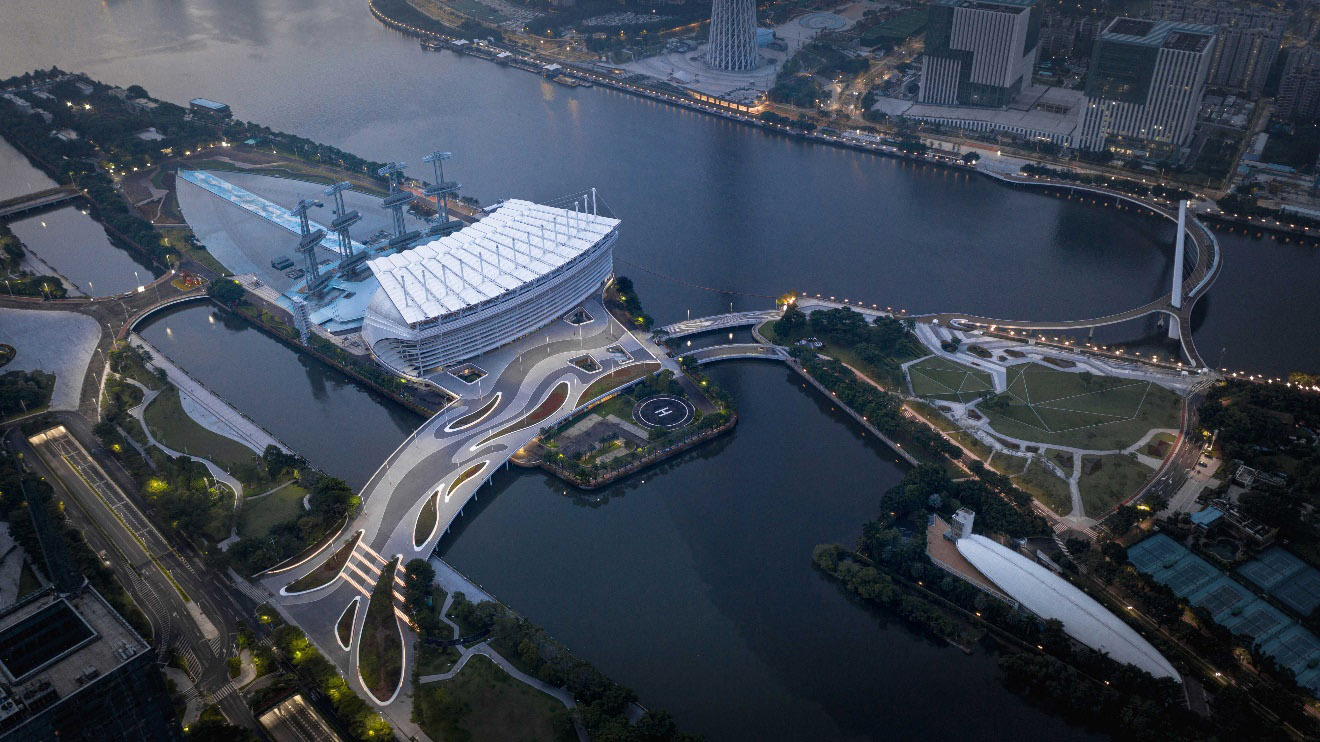
▼项目更多图片

